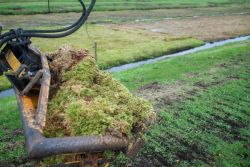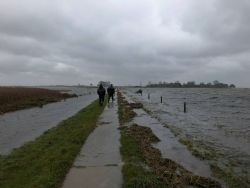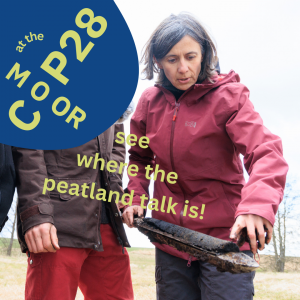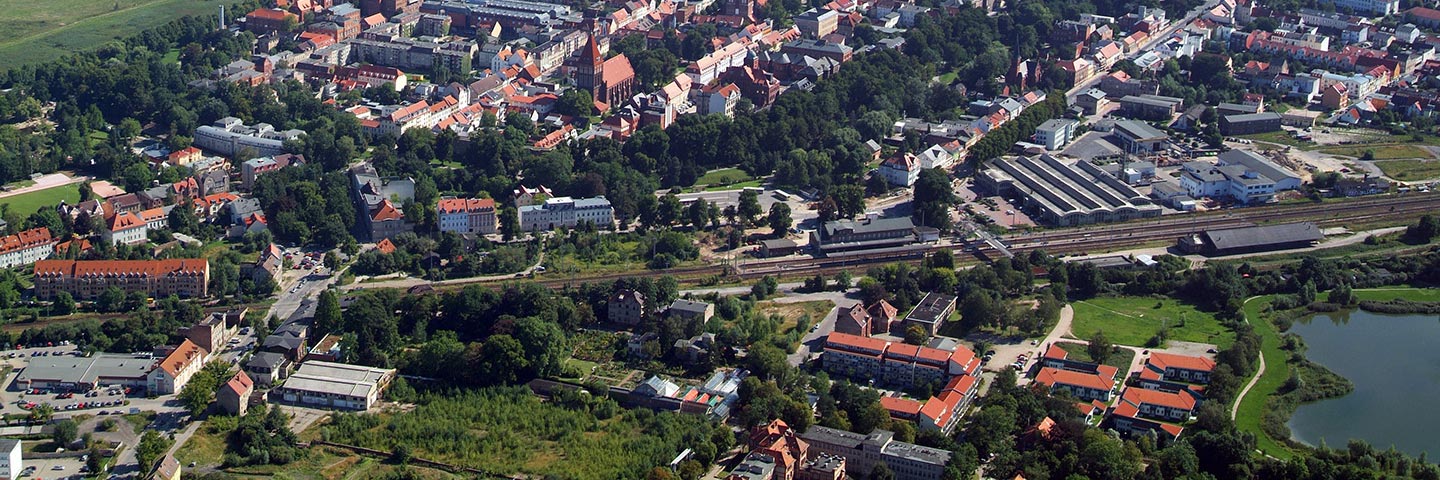News/All pieces
Come to the construction site
Guided tour through peatland library for WWD
23/01/2024 To mark International Wetlands Day on February 2nd, “peatland pope” Prof. Hans Joosten is taking visitors - no, not into a peatland - but to the construction site, both analogue and online! To a building where inspiration will drip from the walls and tens of thousands of books in all genres and languages will be available on one topic: peatland. Renovation work is currently underway in the former lecture hall of the "Alte Chemie (Old chemistry)" at Greifswald, as this will be the new home of the Peatland and Nature Conservation International Library PeNCIL. With 50,000 publications, this special collection is an important part of the Greifswald Mire Centre and of international importance.
In 2024, boxes of books shall move into the listed hall and be accessible barrier-free in the high room with two galleries. Statics, financing, pollution issues - there were and still are many challenges to overcome on the way from the vision of a splendid peatland library to its realisation. Hans Joosten will guide visitors through the wing, which was built at the end of the 19th century, and tell them about its history, the complex mercury decontamination and the new peatland contents. If you can't be there on WWD, you can follow a "small library construction site tour" on the Greifswald Mire Centre Facebook and Instagram accounts that day.
On site, the meeting point is in the inner courtyard of Soldmannstrasse 16 (https://www.google.de/maps/@54.0923148,13.3655688,19z?entry=ttu). As the number of participants is limited, please register at bibliothek@greifswaldmoor.de.
Some more info on World Wetlands Day
World Wetlands Day (WWD) has drawn attention to the importance of wetlands, including peatlands, every year on February 2 since 1997. On February 2nd the Ramsar Convention, the international agreement for the protection of wetlands, was adopted in 1971. Since last year, it has been recognized as an international day by the United Nations.
Due to pollution, drainage and agriculture, fires and overfishing, wetlands, including peatlands, are under threat or have already been destroyed worldwide. Yet they are guarantors of biodiversity and climate protection. Among other things, they offer people protection from drought and flooding, purify water and regulate the microclimate. In Germany, 95 % of former peatlands have been drained and are no longer recognizable as such today
The lecture hall "Old chemistry" of Greifswald University in renovation (Photod: S. Furtak)
Start for MOOSland

for tiny moss on large scale
11/01/2024 With MOOSland, a small plant is supposed to make a big impact – peat moss. This can be grown as a renewable raw material to replace peat in horticulture with great benefits for the climate and the economy. Over the next ten years, MOOSland wants to implement the cultivation and utilization of peat moss biomass, which has already been researched in pilot projects, on a large scale. When grassland is being rewetted for climate protection reasons, the cultivation of peat moss offers an alternative to current drainage-based agriculture. Peat moss stores water in its cells, up to 30 times its own weight. Thus, it provides a renewable raw material with similar properties to the peat formed from it. It is therefore ideal as a peat substitute. MOOSland will now help to investigate and implement peat moss paludiculture on a large scale in an ecologically, economically and socially compatible way. MOOSland is a model and demonstration project by the University of Greifswald and seven partners from Lower Saxony. The Federal Ministry of Food and Agriculture (BMEL) is supporting the project with a total of around 12.5 million euros from the Climate Transformation Fund (KTF); The project sponsor is the Agency for Renewable Raw Materials (FNR).
Wet again – but no flooding

with benefit instead of damage
6/01/2024 It has rained a lot in large parts of Germany in the past few weeks. Many rivers have overflowed their banks, numerous areas are flooded, dikes are giving way and the water is threatening towns and cities. Countless rescue workers and helpers are fighting to limit the damage.
Our use of water is a key reason for the floods: water management today is designed to drain rainwater from the landscape quickly and in a controlled manner. That's why it is crisscrossed with a dense drainage network of ditches, underground drainage pipes, receiving waters, pumping stations, etc. Straightening watercourses also contributes to the water flowing away more quickly. However, when there is high rainfall, this drainage system is overloaded. The water cannot be drained away quickly enough and flooding is the result.
Modeling shows that higher winter precipitation and more heavy rain events are to be expected in the future due to climate change. It therefore becomes even more important to make flood protection safer for the future. Simply thinking about more stable and higher dikes is not enough. Rather, retention areas should be given much greater consideration because they have great importance and great potential for flood protection. Peatlands play a prominent role here. When drained, they can exacerbate flood situations if their peat is degraded and compacted. Wet peatlands, on the other hand, can absorb and store water like a sponge, thus delaying runoff. With a peat formation horizon (so-called acrotelm) in the uppermost decimetres, they are able to “breathe”, so the surface fluctuates depending on the water supply (so-called peat oscillation). Short-term flooding thus does not harm wet peatlands, even if they are used for agricultural purposes in paludiculture. This allows them to buffer flood peaks. This is also why they say “Peatland must be wet!”.
Dreaming of a wet peatland

"We wish you rewetted peatlands" for 2024
22/12/2023 Dear peatland friends, we at the Greifswald Mire Centre are “Dreaming of a wet peatland” (or many) constantly and, of course, at Christmas, too. But we are not dreaming only, but working hard to make it come true. Great thanks to everybody joining and supporting us in these efforts in the past year! For Christmas “We wish you rewetted peatlands, we wish you rewetted peatlands” and a happy new year! We’ll be continuing in 2024…
Biodiversity benefits from paludi-power
New paper in Scientific Reports of Nature
13/12/2023 Data is scarce on how biodiversity is responding to paludiculture. But a new study recently published in Scientific Reports of Nature sheds light on it. A multi-taxon study co-authored by scientists of Greifswald University, partner in the Greifswald Mire Centre, found that paludiculture can support biodiversity conservation in rewetted fen peatlands (DOI 10.1038/s41598-023-44481-0).
The scientists had investigated vegetation, breeding bird and arthropod diversity at six rewetted fen sites dominated by Carex or Typha species in Mecklenburg-Vorpommern in northeastern Germany, either unharvested, low- or high-intensity managed. Biodiversity was estimated across the range of Hill numbers using the iNEXT package, and species were checked for Red List status. It became evident that managed sites had high plant diversity, as well as Red Listed arthropods and breeding birds. Thus, they can provide valuable habitat for species even while productive management of the land continues and although these areas are not reflecting historic fen conditions.
GMC at UNFCCC COP28

#notalkwithoutpeatlands
02/12/2023 We are, where the talk is - on peatlands, of course! Here is a collection of peatland related (side)events on this year’s world climate summit in Dubai, United Arab Emirates from 30th November - 12 December 2023. Participation via livestream is possible for most of them:
On Friday 8th December at 3–4:30pm (GMT+4) Franziska Tanneberger, one of the GMC’s directors, starts participation on the ground with joining the panel of Towards a global stocktake for peatlands and other high-carbon ecosystems: status and scaling up potential. Co-organised by Succow Stiftung, Partner in the Greifswald Mire Centre, United Nations Environmental Programme (UNEP), Wetlands International and Deutsche Bundesstiftung Umwelt (DBU), the event is hybrid and can be followed per livestream / ). The direct link will be available from the 7th December.
On Saturday 9th December, in total, there are four peatland events with GMC participation: At 10:00-11:30, an official COP28 Presidency Event discusses Enhancing food and nature linkages for climate action. It is organised by the Food and Land Use Coalition (FOLU) with COP28 Presidency, High Level Climate Change Champions, and many other organisations including Succow Foundation, partner in the Greifswald Mire Centre. Speakers include Ani Dasgupta (President and CEO, World Resources Institute WRI), H.E. Siti Nurbaya Bakar (Minister of Environment and Forestry, Indonesia), Jochen Flasbarth (Secretary of State, Ministry of Economic Cooperation and Development, Germany), Bruno Pozzi (Deputy Director Ecosystems Division Director, UNEP) and Franziska Tanneberger.
At 1:00-2:30pm (GMT+4) Climate change mitigation through peatland restoration is the topic at the United Nations Office for Project Services (UNOPS) hub. Following in livestream on YouTube is possible.
At 3:00-4:30 pm (GMT +4) a team of African and European peatland scientists reports on in a joint side event of the Global Peatland Initiative and UNEP.
Last but not least, at 4:30-6:00 pm a side event in the German Pavilion focusses on Nature-based Solutions meet Circular Economy: Cascading use of biomass (with livestream). Steffi Lemke, Minister of Environment (Germany), Cem Özdemir, Minister of Agriculture (Germany) and Franziska Tanneberger share recent insights into scaling up paludiculture for climate and biodiversity protection together on the panel.
On Sunday 10th December at 10:00-11:30 am (GMT +4), the panel discussion on “Nature-Based solution for Ukraine. From theory to Practice: forest and water” takes place in the Ukraine Pavilion, peatlands included, of course! Franziska Tanneberger presents the current work of Succow Foundation with many partners on protection and restoration of Polisia peatlands in North-Ukraine.
At 2:00-3:30pm (GMT+4) light is shed on “Enabling the triple win for tropical peatland countries – advancing water, biodiversity and carbon measurements” in a joint side event of UNEP, UNCCD, ITPC, MEOF Indonesia at the Land & Drought Resilience Pavilion. The GMC presents maps and results from our work in tropical peatlands.
As a member of the German Council for Sustainable Development (RNE), Dr Franziska Tanneberger is also a member of the German delegation at the COP. In view of the global rise in emissions, the RNE sees an urgent need for new impetus from COP28. Above all, this concerns the topic of financing climate protection, which the RNE members want to contribute to at the COP.
Photovoltaics on peatlands
Interesting? There are jobs here...
11/21/2023 Do you find photovoltaics on #peatlands interesting? Is this possible and - if so - what effects does it have on biodiversity, greenhouse gases, the formation of peat and the growth of biomass? There are currently two job offers for positions for scientific staff in the Peatlands Research and Experimental Plant Ecology working groups at the University of Greifswald - with the option of a doctorate!
Breakthrough in EU Nature Restoration Law
Webinar: What's next?
10/11/2023 Good news is not always bad news! After today's Friday, the EU Parliament, the EU Commission and the European Council agreed on the law to save nature - the EU Nature Restoration Law (NRL) - in the European Union. It is the largest nature conservation law in 30 years and a breakthrough. Peatlands have also now been included in the law - after they were temporarily no longer taken into account in the negotiations. But what exactly is in the law, when does it come into force and what happens next? An express webinar on the NRL - free and for everyone - explains all this online today at 6 p.m.: Jutta Paulus, MEP, negotiator for the EU renaturation law and environmental policy spokesperson for The Greens/EFA in the European Parliament, Jan-Niclas Gesenhues, environmental policy spokesman for the Alliance 90/The Greens parliamentary group in the German Bundestag and Franziska Tanneberger, head of the Greifswald Mire Centre, University of Greifswald, moderated by Maximilian Fries, Managing Director of Europe Calling e.V.
New poster exhibition
More "ruMooren"
25/10/2023 What is a bog and where exactly is it? What do these bogs emit and is that bad? Can peatlands really help us? The compact, mobile poster exhibition at the Greifswald Mire Centre (GMC) provides questions and answers. From October 24th to November 29th it can be seen in the foyer of the Hans Fallada City Library in Greifswald with seven posters based on the texts and with graphics from the Mooratlas, compiled in the MoKKa project. It can then be shown at other locations upon request.
For Library Day
Reading and poster exhibition
10/23/2023 For Library Day 2023 on October 24th: More ruMOORen! While reading from her book "Das Moor" in the Greifswald city library, Franziska Tanneberger takes Hans Fallada camping on swinging ground in Siberia or bird watching in Senegal. It's about the landscapes between water and land on different continents and also right on our doorstep. In combination, the city library is showing the new poster exhibition "More ruMOORen - moory questions and answers with numbers from the Peatland Atlas". The reading begins at 7 p.m. and admission is free. Not to be forgotten on this day: the Peatland and Nature Conservation International Library (PeNCIL) of the Greifswald Mire Centre. The renovation of an old lecture hall is currently underway in order to be able to preserve, present and use the holdings in sufficient space. The opening is planned for 2024. We're looking forward to it.









